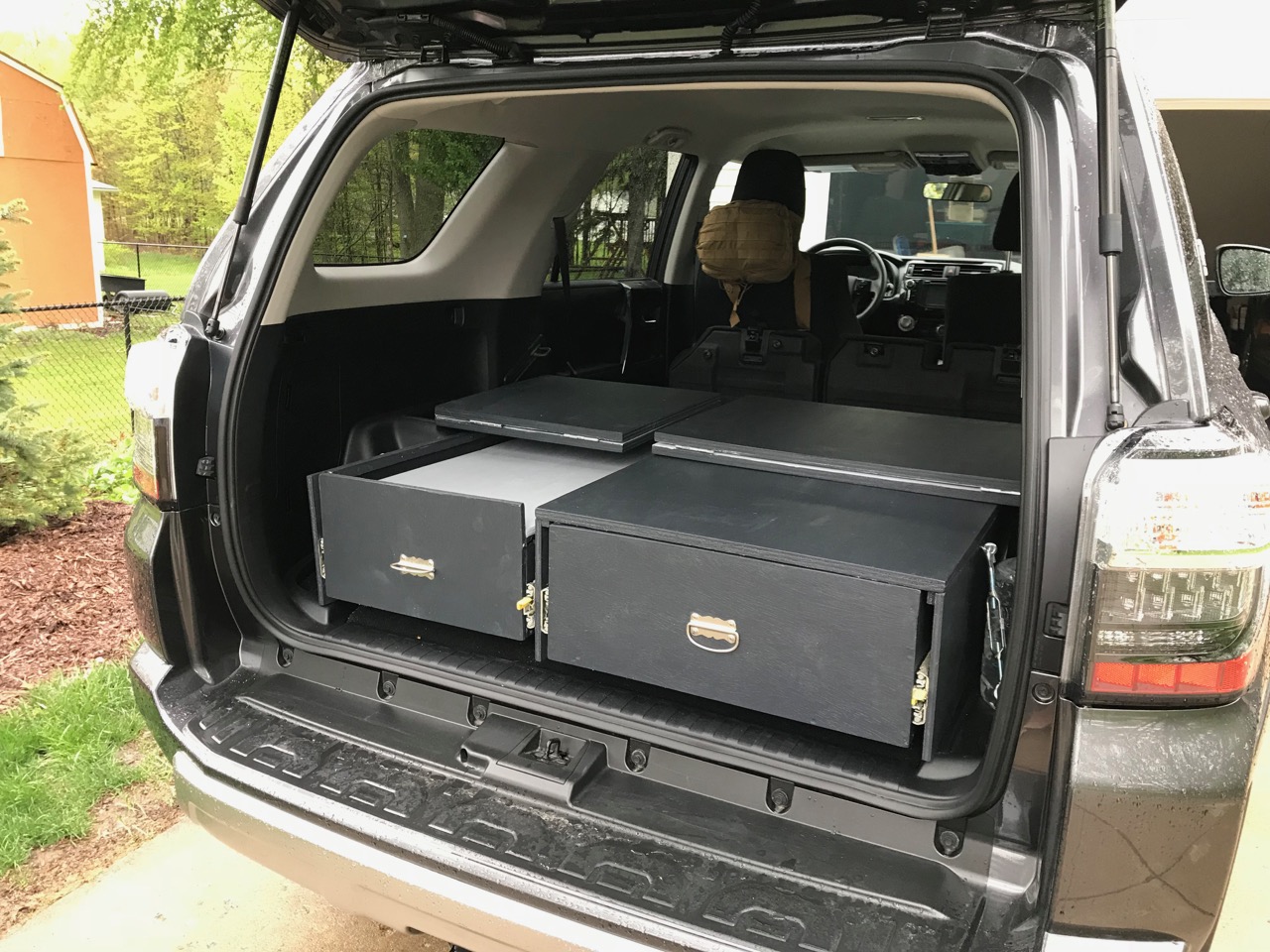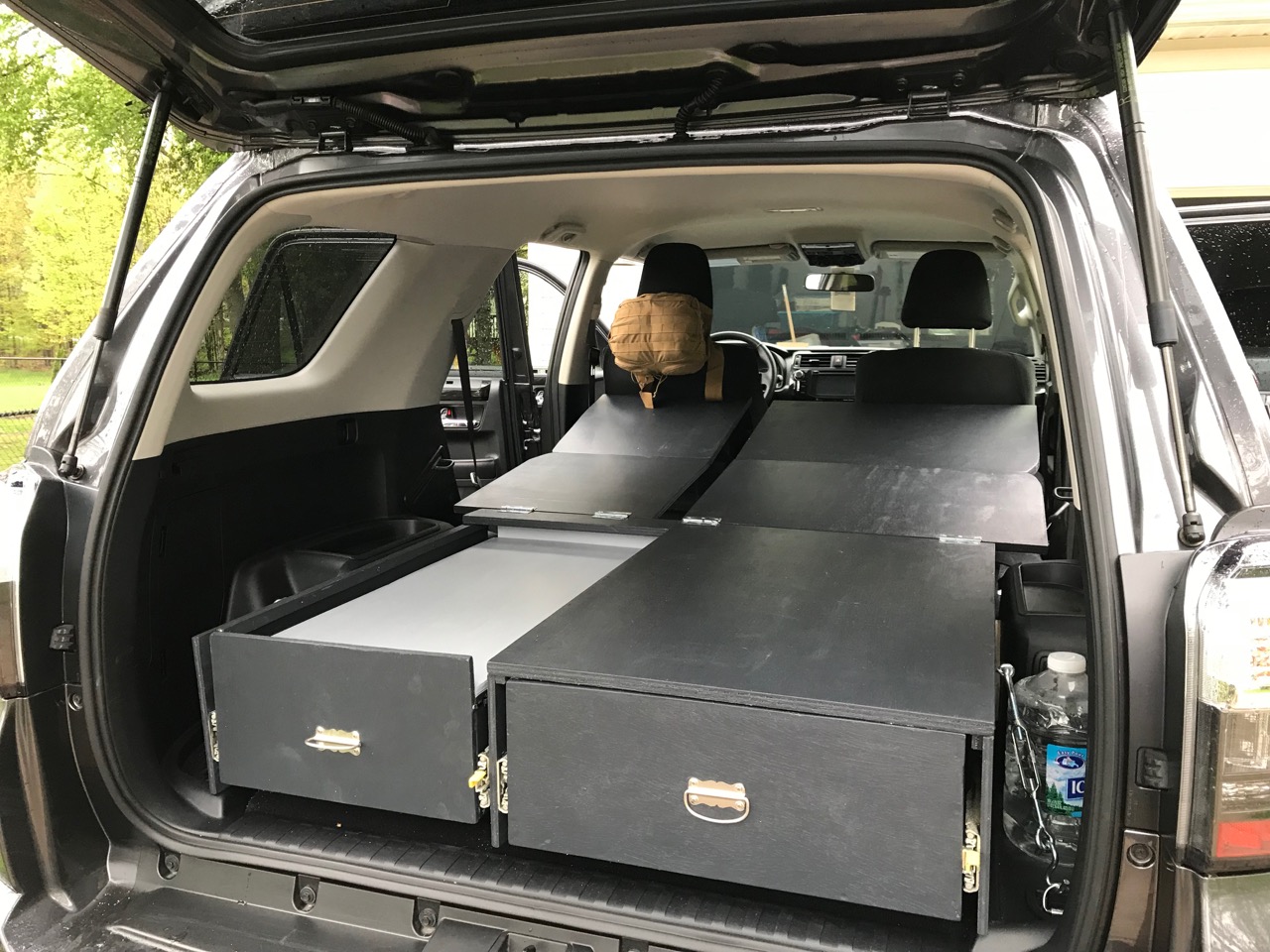Outfitting My 4Runner for Adventure
Today I get to spend some more time on one of my favorite topics, the vehicles you use to get the gear you pack to the places you want to go. I outlined the process that led to my 4Runner in Choosing an Adventure Rig, and today I want to talk about its loadout. In the first part of this article, I will talk about the gear that stays in my vehicle full-time; in the second, I will outline a basic packing list for a typical adventure.
The Everyday Loadout #
Starting up front, I have three dual USB adapters plugged into the center console. One keeps the driver’s and the passenger’s phones charged, while I use the others for two massive RAVPower 26800mAh portable battery packs. Dual QuickCharge 3.0 ports take charge time down from sixteen hours with a single input, to around eight with two. I wanted to minimize that time so that I could get the most out of the occasional resupply run into town, and avoid running my engine for electricity while on the trail. I like to have a small solar panel on-hand to help with this as well. I used a now-discontinued Anker model on short weekend camping trips, in the Canadian backwoods, and on the Mongolian Steppe with zero issues; today RAVPower sells a similar, more powerful model that I stash behind the driver’s seat.
I also keep a small survival kit in the center console. Although I never plan to live out of that small tin, having a backup knife, fire starter, and a few other odds and ends have served me well. I never use anything in this kit, so I always have it to fall back on if I break or lose something on the trail.
In both the driver’s and the passenger’s doors, I keep the same set of equipment: a set of road flares, a trauma first-aid kit, a Leatherman multi-tool, a flashlight, and a regular pocket knife. This leaves enough room for snacks or other small items while on the road, but ensures that both the driver and passenger have quick access to some important tools in an emergency. Neither has to run around the car to the other door for a flashlight, then back to their side for a first-aid kit, for example. If something goes wrong, the focus becomes dealing with the emergency — not locating the means to do so. The one exception to this rule is a fire extinguisher, which stays in the glove compartment, but is accessible from both seats.
Because I never take passengers, I keep the second row of seats stowed, and use the space on top of them for bags and a pair of empty totes. I also hang a much more comprehensive first-aid kit off the driver’s headrest, the contents of which I will talk about soon. Beneath the passenger seat, I stow a portable jump pack, in case I need to jump my car in a remote location. The most interesting aspect of this loadout is the trunk, which houses a custom drawer system and sleeping platform. I plan to dedicate an entire article to it soon, but I will spend some time talking about it now as well.

I use the large drawer on the right for storage. I keep my tent, camp chairs, hammock, and a few blankets in there with room to spare. The left drawer houses a stove that slides out over the removable front panel. I also made this side shorter, to accommodate a large cooler or portable refrigerator. Although cramped, I can get into the cooler from inside the vehicle, or use the locking slides to access it from outside. On a normal day, the inset does a great job of keeping a small backup backpack stationary, which holds a spare set of PTs, an extra uniform, gym clothes, and a small hygiene kit. Again, I plan to talk about the platform’s design and build process soon, with many more pictures, a 3D model, and a build list to share.
On either side of the platform, next to the wheel wells, I stow a few miscellaneous items. A gallon of water, which I use much more often than I would have expected before adding it. A small tool pouch with tools for basic repairs on the road. A pouch of straps and bungee cords for securing loads. Jumper cables. Nothing groundbreaking, just a few things that make my life a little bit easier.
I keep these items in my vehicle for two reasons. First, because I may need them in an emergency. At one end of the spectrum, if my car refuses to start, I can either jump it or fix minor mechanical malfunctions. Failing that, I can handle getting stranded — even in terrible conditions — for a few days. At the other end of the spectrum, if I come upon a serious accident, I have the tools to help secure the area or treat life-threatening injuries until a medical professional takes over. I also keep this equipment in my vehicle because it cuts down on the gear I have to pack in preparation for a trip. This makes the decision to go just a little bit easier, which increases the likelihood that I will.
An Adventure Loadout #
When packing for an adventure, little changes up front: I stow the RAVPower battery packs in the center console, along with a small hand-held GPS unit. I use the Foretrex as a backup for old-fashioned land navigation during field training exercises with the Army. When I go adventuring into unfamiliar territory on my own time, it makes sure I can always find my way back to camp.
Atop the second row of seats, I put two totes side by side: one contains the entire camp kitchen, and the other holds dry goods. The kitchen box consists of a one-pound propane tank for the stove in the trunk, the fantastic MSR skillet and pots along with a Lodge cast iron skillet, enamel dinnerware, cutlery, two dishpan basins, a cutting board, a knife roll that protects the Victorinox knives inside, the Wolf & Grizzly M1 Portable Grill, a Jetboil Flash, a single fuel canister, and a Jetboil coffee press, a small cooking set, dish soap, hand towels, an oven mitt, and a canister of Clorox wipes. It takes some work, but everything fits into a single container. I slide an ALPS Mountaineering Dining Table between the totes and the front seats, which fits just well enough to keep everything from moving around too much.

The sleeping platform, which lays on top of those totes as shown in the picture above, then serves as the base for any personal bags taken on the trip. If I cannot make camp for some reason, I can move those bags into the front seats and sleep inside the vehicle. I have done this a few times, and although not spacious, I slept well.
I like to plan for the worst-case scenario, so everything I need to make camp in poor conditions stays in the storage drawer in the trunk. I can park, slide it open, and have easy access to my tent, a rain fly, rain gear, and bug spray right away. I store chairs, a hammock, and other small items in here as well, but toward the back to keep more important gear front and center. In a tote on top, I store an air mattress, its pump, several blankets, pillows, and a sleeping bag, strapped down to keep it from sliding around. Depending on how long I plan to travel, I will strap down one or two Reliance Products 7 gallon Aqua-Tainers. If I elect to sleep inside the vehicle, the weatherproof tote can either go up front or outside, and the water jugs can go behind the cooler or outside as well. The cooler sits atop its own drawer, for easy access in camp.
Because I keep emergency gear in my vehicle at all times, and compartmentalize everything else into two totes and a cooler, it does not take long to go from zero to adventure-ready. Toss some clothes in a backpack, carry everything out of the closet, stop by the grocery store on my way out of town, and I can disappear for a weekend with minimal time spent preparing for the trip. This sleek setup makes traveling easier, much less stressful, and far less complicated than it would be with meager organization. As a result, I adventure more, and have more fun doing it.